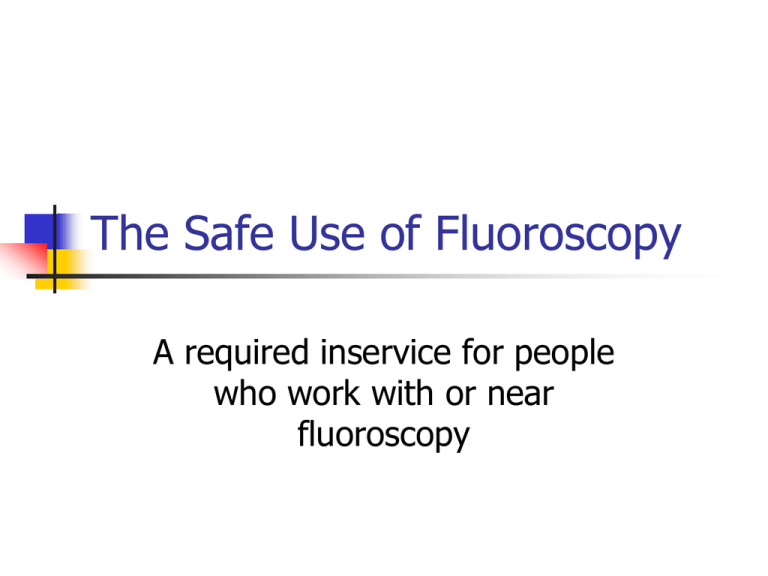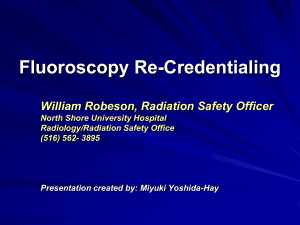The Safe Use of Fluoroscopy
advertisement

The Safe Use of Fluoroscopy A required inservice for people who work with or near fluoroscopy The FDA says . . . “The Food and Drug Administration Center for Devices and Radiological health has received reports of occasional, but at times severe, radiation-induced skin injuries to patients resulting from prolonged, fluoroscopically-guided, invasive procedures. Physicians performing these procedures should be aware of the potential for serious, radiation-induced skin injury caused by long periods of fluoroscopy during these procedures.” from FDA Public Health Advisory, Sept. 30, 1994 The State of Ohio says . . . “All individuals operating fluoroscopic equipment, and individuals likely to receive an annual effective dose equivalent in excess of 1 mSv from participating in fluoroscopic procedures, shall receive at least two hours of radiation protection training specific to fluoroscopy in addition to [other required training]. . . prior to performing or participating in fluoroscopic procedures.” Ohio Administrative Code 3701:1-66-07 (G) The Kettering Health Network says. . . All persons operating or working directly with fluoroscopy equipment at any KHN facility must have proof of taking this inservice or an equivalent one at any other facility within the State of Ohio. The Good News This inservice is only required once before working with fluoroscopy. (A high badge reading may require that you take a one-hour refresher course.) This inservice is good anywhere in the State of Ohio. If you have done a similar inservice at another facility within Ohio, provide the Radiation Safety Office with documentation, and you are excused from this one. One Little Detail While this training is good for each hospital where you work, it must be approved by the Certified Radiation Expert (CRE) for that hospital. You may need to provide a copy of this presentation to the CRE. Who’s Who The Ohio Department of Health, Bureau of Radiation Protection is responsible for enforcing rules concerning the safe use of radiation, including fluoroscopy. Information on how to contact them is posted in every radiation use area throughout the network. They are also on-line at www.odh.ohio.gov. Who’s Who The Kettering Health Network Radiation Safety Office is responsible for overseeing radiation safety throughout the entire Network. They are located on the ground floor, NW wing of Kettering Hospital. They have a site on the KHN intranet (which may be where you are viewing this presentation.) The Radiation Safety Office Radiation Safety Officer Steven Cartwright, PhD, DABR, DABMP 395-8818, pager 370-0006 Radiation Safety Specialist Mark Berner, MBA 298-3399, X57704, pager 370-0005 Who else is Who The Food and Drug Administration (FDA) is responsible for the safe design of X-ray units, including fluoroscopes. They do not govern the use of fluoroscopes, but in 1994 they alerted the medical community to the possibility that fluoroscopy can be misused and cause really ugly skin burns to patients. Some of those pictures will show up later in this presentation. Some Ohio basics In the State of Ohio only licensed operators can use a fluoroscope on humans. Physicians are specifically exempted from needing a license. They can use a fluoroscope on anybody as long as it’s within the scope of their practice. NO NURSES! (Unless they hold a radiographer’s license, in which case they are RTs as well.) THE PHYSICIAN IS ALWAYS RESPONSIBLE FOR APPLYING RADIATION TO A PATIENT, NO MATTER WHOSE FOOT IS ON THE PEDAL. What Are X-rays Anyways? X-rays are high-energy electro-magnetic waves generated by machines. X-rays are exactly the same as visible light, only with 30,000 times more energy. Because of their high energy X-rays can penetrate tissue, but they aren’t so good with bone. The difference in penetration makes up the classic X-ray image. The Classic X-ray Image The first X-ray image taken by Wilhelm Roentgen. Incidently, that’s Mrs. Roentgen’s hand. You didn’t think Wilhelm would expose himself, did you? An X-ray Myth X-rays do not stay in the body. They don’t make you radioactive. They don’t make you glow. When you turn off the X-ray machine they’re gone, just like the light from a light bulb. People who have had an X-ray procedure don’t pose any special threat to the rest of the world. Unless they text while driving. Fluoroscopy Fluoroscopy is real-time X-ray imaging. Instead of a piece of film, the fluoroscope image is formed on an image intensifier (the “II”). It is displayed on a TV monitor. Types of Fluoroscopes General purpose fluoroscopes may have the X-ray head under or over the table. Over-table units can be used for general radiology as well. The II on an under-table unit is called the tower for an obvious reason. Stationary Fluoroscopes Undertable X-ray head Image intensifier Over table Types of Fluoroscopes If the X-ray head and II are linked together by a large C-shaped arm the fluoroscope is a called a C-arm. Mobile C-arms can roll around. Mini Carms are tiny fluoroscopes used only for extremities. C-arms Mobile C-arm Mini C-arm Fixed C-arm Proper Positioning Whenever possible, position the X-ray head under the patient. (This isn’t possible on an over-table unit.) The X-ray source (inside the head) must be at least 12” away from the patient’s skin. This is built in to most fixed units. C-arms have spacer cones to keep the right distance. Foot Pedals All fluoroscopes of any type are operated by a foot pedal. The pedal is a “dead man” switch. The machine will only operate when there is pressure on the switch. Presumably if you die while operating a fluoroscope you will release the foot pressure. Image Intensifiers The Image Intensifier (II) converts the radiographic image into a TV image and makes it considerably brighter. The II may be a large vacuum device or a flat panel. II’s can magnify the image. Image Intensifiers Flat Panel Tube The Fluoroscopic Image Compared to conventional X-ray images, fluoroscopic images are grainy. This is because fluoro images use as little radiation as possible. Less radiation = more noise (image grain) More noise = harder to see fine detail Image Noise The grainy appearance of an image is called noise. It’s just like static on the radio. The main cause of noise is too little radiation. Too much radiation makes a great image but overdoses the patient—and you. The Effect of Noise The image is the same each time, but the noise increases. In the noisiest image (right) the dim circles are still there, but you can’t see them. This is like fluoroscopy. Why this is OK Fine image resolution is needed to diagnose unknown conditions. You need to see everything. Fluoroscopy is rarely used for diagnosis. Under fluoro you’re usually looking for something large or filled with contrast, and sometimes both. Formal discussion of X-ray imaging to follow Generating X-rays X-rays are generated in a vacuum tube. Electrons from a cathode accelerate under high voltage towards an anode. When the electrons hit the anode they slow down abruptly and generate Xrays in the process. The X-rays escape out a window in the tube and become useful. An X-ray Tube X-ray Technique The energy of the X-rays is determined by the voltage applied to the anode (commonly called the kilovoltage or kV). The intensity of the X-rays is determined by the flow of electrons from the cathode to the anode. The electron flow is often called the mAs (for milliamp-second). Together the kV and mAs make up the X-ray technique. X-ray Technique—kV The kV determines how much energy gets through the subject. Use high kV to penetrate bone, large people, or large boney people. Use low kV to show soft tissues. X-ray Technique—kV kVs range from about 25 kV for mammography to 150 kV for chest Xrays. Typical fluoroscope kVs are in the 50 kV to 80 kV range. X-ray Technique—mAs The mAs determines the total amount of radiation used to make an image. In a conventional X-ray the time (s) is very short and the tube current (mA) is fairly large. Fluoroscopy uses a small mA, but exposures may run for several seconds. The result is a moving, but grainy image. X-ray Technique—kV and mA Typically, the kV is set to penetrate the chosen body part, and the mA is adjusted to give a suitable image. In fluoroscopy this procedure is usually done automatically in a process called auto-fluoro. Auto-fluoro Step on the pedal and the machine automatically adjusts the kV and mA to give a good image. As you move the fluoroscope around the kV and mA automatically adjust. You may not know at any moment just what the kV and mA are. Pulsed Mode Fluoroscopy often uses pulsed X-rays. The radiation is emitted in small bursts from 2 to 30 times per second. Anything higher than 30 times per second looks like a continuously moving image to the human eye. At slower rates the image may look jerky, but it is still useful for most tasks. Patient Dose Only a small portion of the radiation from a fluoroscope makes it to the II. The rest stays in the patient. This energy is the patient dose. The patient dose is responsible for damage to a patient’s skin or increase in cancer risk. More about this later. Just keep reading. If you thought Physics was bad, now it’s The Terms We Use Three different terms are used to describe the interaction of radiation with the human body (well, anything, actually). Exposure—The “amount” of ionizing radiation present at a point in space Dose—The amount of energy absorbed in a mass of tissue Effective Dose—A derived quantity that describes the biological effect of absorbed radiation These three concepts are closely related, but measured by different units with slightly different meanings. The Units We Use There are two sets of units used to describe radiation—older ones, often found in textbooks, and newer ones that conform to the conventions of the System Internationale. The relation between them is sort of like the relation between currencies. Two kinds of currency both describe the value of something, but they use different numbers and units. (Anybody who ever had to work with the old British system of pounds, shillings, and pence can appreciate this.) The Units We Use (the m before a unit stands for milli-, or 1/1000th) Old Units Exposure—Roentgen (R, mR) Dose—rad (r, mrad) Effective dose—rem (rem, mrem) New Units Exposure—Air Kerma (no accepted abbreviation yet) Dose—Gray (Gy, mGy) Effective dose— Sievert (Sv, mSv) Where You Find These Terms The radiation output of an X-ray machine is usually described by the exposure rate, R/min, measured at a fixed point in front of the X-ray head (usually 1 meter or 40 inches). The dose (sometimes called organ dose) is calculated to determine the effect of radiation on a particular organ. This is used a lot in radiation therapy treatment planning. The effective dose is calculated from the exposure of a film badge and reported as part of your monthly badge reading. Biological Effect of Radiation Radiation ionizes (knocks off electrons from) atoms. In the human body, mostly it ionizes water. The ionized water breaks up into radicals that break DNA chains. The Mysteries of DNA If left alone long enough, a broken DNA chain can repair itself. No harm done. If the cell divides before the chain repairs itself, the cell dies. Enough cells die and bad things happen. Cells die when they divide too fast to repair themselves or when the radiation is coming in too fast to give them a chance. Radiation Sensitivity Rapidly dividing cells (most sensitive) sperm lymphocytes small intestine stomach Slowly dividing cells (least sensitive) bone skin nerves colon The Nature of Radiation Damage Radiation damage seldom appears at the time of irradiation. Visible effects occur later, from several hours to nearly a year. The first (almost) visible effect is a drop in the white blood count. The first external visible effect is a skin burn. A Note About Radiation Therapy Cancer cells divide much more than normal cells. Radiation kills both normal and cancer cells, but the cancer cells have less opportunity to repair themselves. Repeated applications of radiation eventually kill all of the cancer cells while the normal cells recover. Why This is Important Diagnostic X-ray procedures do not usually use enough radiation to cause damage. Fluoroscopy is the one modality capable of delivering sufficient energy to one spot so as to cause damage.* Educating the operators can prevent damage from occurring. *Recently a CT was used to burn people. Who knew it was possible? Radiation Damage Stochastic effects Amount of radiation determines probability of effect Once it happens the effect does not improve when the radiation is taken away Death is the ultimate stochastic effect Non-stochastic effects Amount of radiation determines severity of the effect When the radiation is taken away the effect improves Skin burns are most common non-stochastic effect Radiation Damage Radiation damage is not apparent at the time of irradiation. There is no physical sensation to being irradiated! The severity of the effect depends on how much area was irradiated. Small areas can tolerate higher doses. More Radiation Damage Effects show up days or weeks later depending on how much radiation was used. The more radiation, the quicker the effect appears. Patients may not associate a square sunburn with the heart cath they had three weeks ago. It’s up to the physicians to be alert for late effects of radiation. What does it take to cause damage? Erythema is the first visible effect from radiation. It takes about 200 rad (or 2 Gy) to cause reddening (a chest X-ray is only 0.5 rad, or 5 mGy). Ulceration occurs at 2000 rad. These are large numbers, but well within the ability of a fluoroscope. It’s Possible. . . The maximum output of a fluoroscope is limited by law to 10 R/min at the patient’s skin surface (20 R/min on boost mode). At that rate skin reddening can occur in about 20 minutes (10 minutes on boost mode). At more typical rates reddening can occur with about 50 to 200 minutes of continuous fluoro time. Ciné (a fluoroscopy movie) is taken at high—and not limited—rates. Skin burns can occur in as little as 2 minutes. Radiation-Induced Skin Injuries (from the FDA Physicians Advisory) Effect Threshold Dose (Gy) Hours of regular fluoro Minutes of Time to boost onset after fluoro fluoro Early transient erythema 2 1.7 10 Hours Temporary epilation 3 2.5 15 3 weeks Permanent epilation 7 5.8 35 3 weeks Moist desquamation 15 12.5 75 4 weeks 15 90 >10 weeks Dermal necrosis 18 Gross (but real) pictures The following slides are taken from “Radiation-induced Skin Injuries”, presented by Thomas Swope of the FDA at the 1995 meeting of the Radiological Society of North America. 49-year-old woman with 8-year history of refractory supraventricular tachycardia. Sharply demarcated ulceration above elbow 5 months after radiofrequency cardiac catheter ablation. 56-year-old man with obstructing lesion of right coronary artery. Posterolateral chest wall at 10 weeks after percutaneous transluminal coronary angioplasty shows 12 x 6.5 cm hyperpigmented plaque with hyperkeratosis below right axilla. Skin wound caused by an estimated 2 hours of fluoroscope time during coronary angioplasty. The first symptoms appeared six to eight weeks after the procedure. The wound appeared to heal spontaneously and then reappeared. This photograph was taken 18 to 21 months following the procedure. Reminder All the preceding damage was caused by hours of continuous fluoro time. The damage appeared (and worsened) months to years after the original exposure. It takes work, but it’s possible to cause damage with a fluoroscope. A Subtle Effect Any radiation exposure increases a person’s likelihood of developing cancer eventually. The effect is very small and takes about 20 years to manifest itself. This is not much of a concern for older adults, but is a real problem with children. Always use dose-reduction techniques (to be discussed) during a pediatric case. A More Immediate Effect The eyes are fairly sensitive to radiation About 200 rad (2 Gy) can induce temporary cataracts About 500 rad (5 Gy) can make them permanent THESE VALUES ARE WELL WITHIN THE REALM OF POSSIBILITY, ESPECIALLY OVER A LONG TIME! Studies suggest that people who use fluoroscopy extensively have a higher rate of cataracts. I Repeat. . . Did you catch that last sentence? Studies suggest that people who use fluoroscopy extensively have a higher rate of cataracts! Think about it Using Fluoroscopy Safely Your Dose The only three things that mitigate the dose to you are time, distance, and shielding. We measure your dose with a film badge (actually a personal dosimeter— they don’t use film anymore). Film Badges A film badge only records how much radiation you’ve received. It doesn’t protect you. A film badge only works if you wear it. Seems obvious? A lot of people forget that little detail. If you don’t wear it, we won’t know how much radiation you’ve gotten, and we won’t warn you if a dangerous situation is developing. Time This one’s easy. Hold down the amount of time you’re near an operating fluoro beam. Leave the fluoroscope off unless you absolutely need it to see something inside the patient. The Effect of Distance Radiation intensity follows the inverse square law: The intensity drops as 1 over the square of distance from the source. If you are 1 foot from an X-ray source and you move to 2 feet away, your exposure drops by a factor of 4. Move 3 feet away and it drops by 9. You get the idea. But. . . . . . it works the other way, too. Exposure increases as you move closer to the source. If you are 12 inches from an X-ray source and you move 3½ inches closer, your exposure doubles. Moral: Stay back from X-ray sources. Shielding Lead gowns and aprons are terrific for stopping fluoroscope radiation. Some gowns don’t close in the back, so make sure your back is not toward the source. Some rooms have fixed drop-down shields are rolling floor shields. These work really well, too. Shielding Thyroid collars should also be worn near fluoroscopes. Lead glasses are useful if you must have your head next to a beam, but many people find them awkward. Try to keep your head away from the beam. Shielding and Film Badges Your film badge must be worn on the part of you “most likely to be exposed”. If you wear a lead apron, with or without a thyroid shield, put the badge at your collar because it represents the dose to your eyes. If you also wear lead glasses the badge can go under your apron because all the important stuff is covered. Patient Dose The biggest contributor to patient dose is low-energy radiation that is always part of the beam. These X-rays can be (mostly) removed before they reach the patient by filtration. Thin sheets of aluminum or copper are put in the beam to remove the low-energy X-rays. The remaining higher-energy radiation penetrates the body more readily. We say the beam is hardened by using filtration. Beam Hardening A hardened beam will lower the patient dose with no decrease in image quality. (Those low-energy X-rays never made it to the II any way.) Modern fluoroscopes can automatically insert extra filtration when it is required. Older fluoroscopes require manual insertion of filtration. This isn’t done much. How to Mitigate Radiation Exposure Use fluoroscopy sparingly. Never let the fluoroscope run while you’re thinking about what to do next. Keep the X-ray head away from the patient. Keep the patient as close to the II as possible. (That gives a better image anyway.) Keep the fluoroscope moving. Radiation does less damage if it’s spread over a larger area. How to Mitigate Radiation Exposure Whenever possible, keep the X-ray head below the patient and the II above. This puts most of the scattered radiation around your ankles. And frankly, we don’t care a lot about your ankles. It also keeps you from sticking your hand in the unattenuated beam. How to Mitigate Radiation Exposure Always use a high kV and high filtration to lessen the dose to the patient. Mostly this is handled automatically by the machine. Use pulsed modes. You don’t always need a continuous image. Collimate the beam only to the area you are using. How to Mitigate Radiation Exposure Use magnification sparingly Magnification modes increase the output of the machine and dose to the patient, but don’t provide that much more information. Never apply radiation unless you know exactly what you’re trying to accomplish. Or just leave the darn thing off A Word about Ciné Mode Ciné was originally a term for film movies made with fluoroscopy. The term is still used for high-resolution digital moving images. Ciné requires intense, short bursts of radiation. The exposure level can easily be 5 to 10 times higher than normal fluoroscopy. A Word about Ciné Mode Fluoroscopes limit ciné runs to less than 30 seconds to prevent overexposure of the patient and overheating of the fluoroscope. Multiple ciné runs can quickly cause skin burns and worse. USE CINÉ SPARINGLY! Other Resources The American College of Radiology (ACR) publishes appropriateness criteria and dose guidelines for all manner of radiation procedures. The American College of Cardiologists (ACC) recommends its Appropriate Use Criteria to reduce inappropriate imaging. Image Gently, a campaign to reduce CT dose to children, has a program called Step Lightly to reduce dose from interventional imaging. All of these resources and more are available on-line. One Last Thing The patient may get the brunt of the radiation, but the staff—including the physician—is also being irradiated at the same time by scatter. When you protect the patient you protect yourself. ALARA Always keep the radiation dose As Low As Reasonably Achievable.








